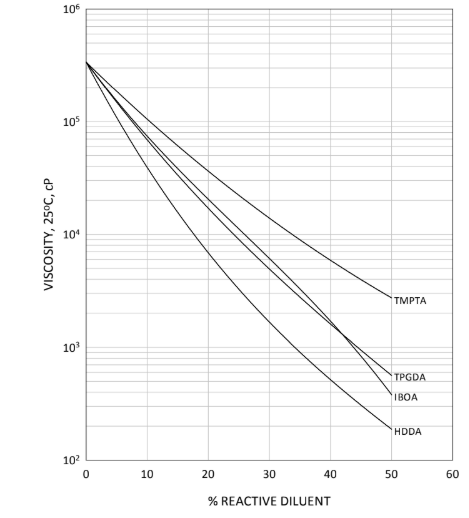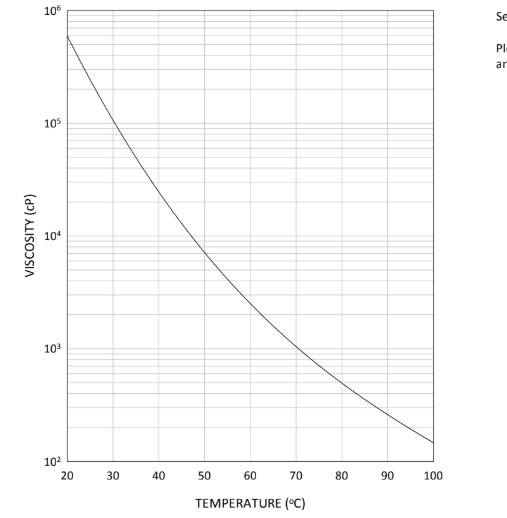Enhanced TDS
Identification & Functionality
- Blend
- No
- CASE Ingredients Functions
- Chemical Family
- Function
- Monomer
- Product Code
- MITM10806
- Single Ingredient
- Yes
- Technologies
- Product Families
Features & Benefits
- CASE Ingredients Features
- Product Benefits
- Excellent UV/EB cure response
- High functionality
Applications & Uses
- Application Method
- Coating End Applications
- Cure Method
- Ink & Toner End Applications
- Markets
- Applications
- Product Applications
- Solder mask
- Screen inks
- Abrasion resistant coatings for rigid plastics
- Electronic marking inks
Properties
- Physical Form
- Product Properties
- High surface hardness
- High gloss
- Good chemical resistance
- Good thermal resistance
Technical Details & Test Data
- Technical Data

Graph 1 shows the viscosity reduction of EBECRYL® 3603 with 1,6-hexanediol diacrylate (HDDA), isobornyl acrylate (IBOA), trimethylolpropane triacrylate (TMPTA), and tripropylene glycol diacrylate (TPGDA). Although viscosity reduction can be achieved with non-reactive solvents, reactive diluents are preferred because they are essentially 100 percent converted during UV/EB exposure to form a part of the coating or ink, thus reducing solvent emissions. The specific reactive diluents used will influence performance properties such as hardness and flexibility.
EBECRYL® 3603 - VISCOSITY VS. TEMPERATURE

Packaging & Availability
- Packaging Type
Principal Information
- Group Principal Number
- S000001
- Principal
Storage & Handling
- Storage Conditions
- Care should be taken not to expose the product to high temperature conditions, direct sunlight, ignition sources, oxidizing agents, alkalis or acids.
- This might cause uncontrollable polymerization of the product with the generation of heat.
- Storage and handling should be in stainless steel, amber glass, amber polyethylene or baked phenolic lined containers.
- Procedures that remove or displace oxygen from the material should be avoided.
- Do not store this material under an oxygen free atmosphere.
- Dry air is recommended to displace material removed from the container.
- Wash thoroughly after handling.
- Keep container tightly closed.
- Use with adequate ventilation.
Other
- Appearance (SDS)
- Liquid
- Color (SDS)
- Yellowish
- Item Number
- Odor (SDS)
- Ester acrylate
- Other Hazards
- Polymerization may occur from excessive heat ,contamination or exposure to direct sunlight , Contact with skin may cause a cross-allergic reaction in persons already sensitized to acrylates.
- Protect from Freezing
- Yes
- Temperature Control
- Yes
- USA/DOT UN Number
- Not Applicable
- Chemical Properties
Value Units Test Method / Conditions Acid Value max. 3.0 mg KOH/g mg KOH/g Epoxy Group Content max. 0.27 % % - Material Composition
Value Units Test Method / Conditions Oligomer Content 80.0 %(W/W) %(W/W) - Mechanical Properties
Value Units Test Method / Conditions Elongation 8.0 % % at break, UV cured 125 μ thick films Tensile Strength 9300.0 psi psi at break, UV cured 125 μ thick films - Optical Properties
Value Units Test Method / Conditions Color Scale max. 5.0 Gardner Gardner Gardner Color Scale - Physical Properties
Value Units Test Method / Conditions Density 1.19 g/mL g/mL At 25°C Glass Transition Temperature (Tg) 54.0 °C °C Dynamic Mechanical Analysis (DMA) at break, UV cured 125 μ thick films Storage Temperature 39.2-104.0 °F °F Viscosity 900.0-1900.0 mPa.s mPa.s at 65.5°C - SDS Physical and Chemical Properties
Value Units Test Method / Conditions Boiling Point (SDS) min. 100.0 °C °C Density (SDS) 1.19 g/cm³ g/cm³ Vapor Pressure (SDS) max. 1.33 hPa hPa at 20°C Viscosity (SDS) 900.0-1900.0 mPa.s mPa.s at 65.5°C Volatile Content (SDS) max. 0.5 % % - Shelf Life & Stability
Value Units Test Method / Conditions Shelf Life 0.0 d d
